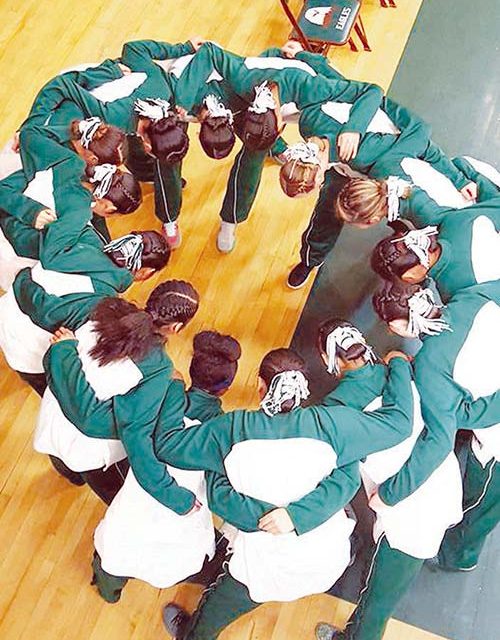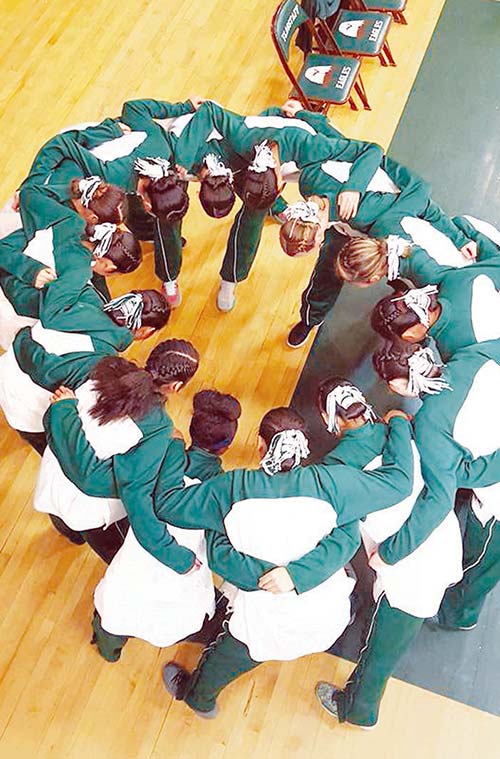
Controversy on a bun

Submitted The Flagstaff Lady Eagles bow their heads in prayer before their game against Greenway Tuesday night, showing their traditional hair buns. Pauline Butler, the aunt of one of the players, said the team says a prayer in Navajo, Hebrew and English before each game.
Lady Eagles told to take out their tsiyeels

Submitted
The Flagstaff Lady Eagles bow their heads in prayer before their game against Greenway Tuesday night, showing their traditional hair buns. Pauline Butler, the aunt of one of the players, said the team says a prayer in Navajo, Hebrew and English before each game.
CHINLE
To the Lady Eagles basketball team, it was an expression of Native pride and team solidarity.
To the referees, it was a violation of the uniform code that could present a hazard to other players.
In the end, the buns came out. But this probably isn’t over.
At Tuesday night’s game between Flagstaff and Greenway High School, which fell on Flagstaff High School’s Native American Heritage Day, the mostly Native team celebrated by tying their hair in traditional Navajo buns.
“Even the three white girls did it,” said Pauline Butler, the aunt of one of the players and the tie-er of the buns. “They were the first in line to get it done.”
The tsiyeels didn’t last long, however. Two of the three referees told the girls to take out the buns and put their hair in ponytails if they wanted to play.
“Their first reason was the colors,” Butler said. “The two teams had the same colors, and the refs thought the white and green strings might confuse the players.”
They also cited a safety issue, saying other players’ hands could get caught in the dangling ends of the string.
“Which makes no sense,” said Butler. “Some of these girls have hair past their waist. It’s much longer than the strings.”
Greenway, Butler pointed out, had some African-American girls on their team with long hair weaves, but they weren’t called on it.
The Arizona Interscholastic Association’s commissioner of officials did not return an email asking for the refs’ side of the story. But one spectator, after looking up the rule, took their side.
“For me, I’m Navajo and I was all bummed about it when the girls had to take their hair down,” said Philbert Haskon. “But then I got online and looked up the rules.”
Haskon said there is a rule in the national handbook for girls’ basketball that a hair tie has to be all one color. The Flagstaff girls’ hair was tied with a mixture of green and white string.
“It looked all pretty and everything,” he said, “but the refs have to follow the rules.”
Flagstaff High Athletic Director Jeannine Brandel had to make the call to either ask the girls to untie their hair or forfeit the game. She did the former.
“She didn’t really have a choice,” said Butler. “It was either that, or the game wouldn’t count and the girls wouldn’t have had a chance to play.”
Brandel said she didn’t know the girls were going to tie their hair or she might have cautioned them about the rules.
“I was busy attending to other things,” she said. “I didn’t even realize it was going on.”
Brandel said she didn’t think it was racism; “It was nothing more than someone enforcing the rule as it’s written,” she said.
Butler said she would like to see the rule, and if it does prohibit the tsiyeel, maybe it needs to be modified.
“It’s actually a great way to wear your hair when you’re playing sports,” she said. “It keeps it out of your eyes. It doesn’t flop around and hit you in your face like a ponytail.”
Besides, she said, in Arizona, “Basketball is a Native game. We love it.”
Although the refs’ decision put a bit of a damper on the evening, the Eagles went on to win the game 52-42.
“It was still a really nice night,” said Brandel, noting that there were many other activities honoring Native Americans — the national anthem sung in Navajo, a drum group, a tsiyeel-tieing competition at half-time.
“It was a nice night,” agreed Butler. “Flagstaff High School is very respectful of its Native students.
“Every party has a pooper.”
To read the full article, pick up your copy of the Navajo Times at your nearest newsstand Thursday mornings!
Are you a digital subscriber? Read the most recent three weeks of stories by logging in to your online account.








 Highway 264,
Highway 264, I-40, WB @ Winslow
I-40, WB @ Winslow